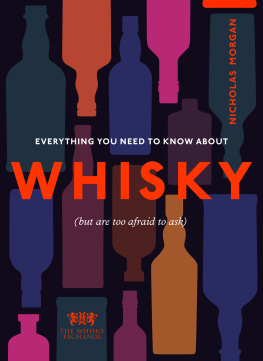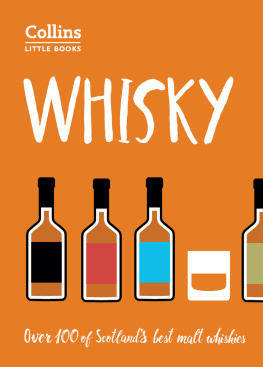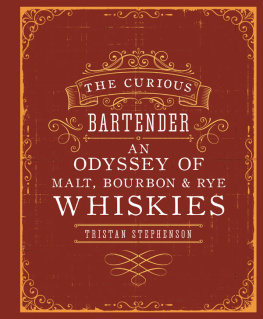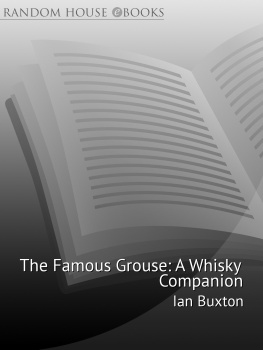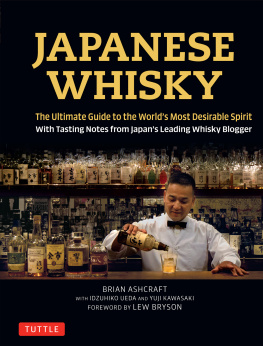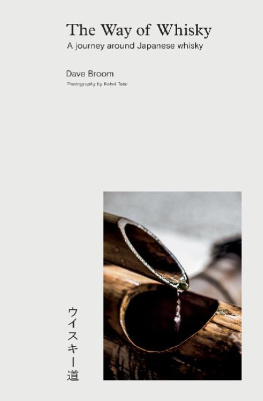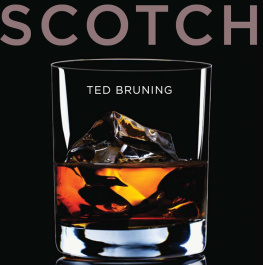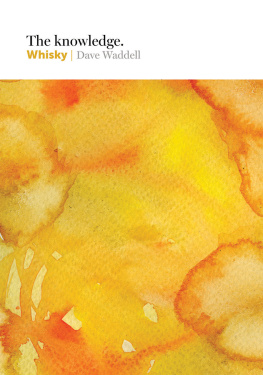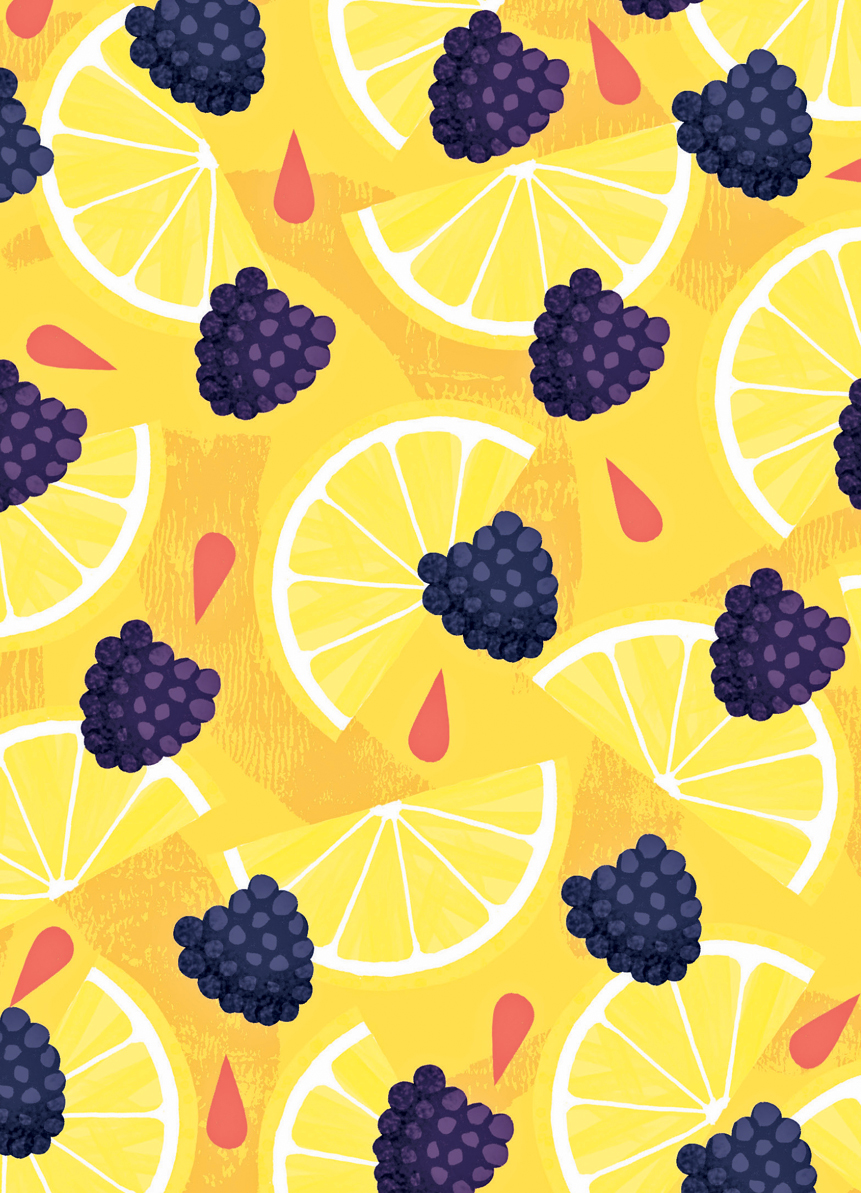
CONTENTS
I like whisky and bourbon and Scotch.
I cant tell you how often I hear that statement, but in reality, bourbon and Scotch are both types of whisky. Just as the word beer is a broad-based word including ales and lagers whisky is a catch-all for spirits made from cereal grains that have (usually) been matured in a wooden container.
The world of whisky can be a little confusing, but this book should help you to understand its many forms and production methods. A good place to start is to imagine whisky as beer that has made a leap for immortality. Grain, water and yeast are the backbones of both beer and whisky, the difference being that beer uses hops, while whisky is distilled to concentrate the flavours and alcohol.
Whisky has a long history, particularly in Scotland and Ireland, its veritable homes. So, which country invented whisky? Its an argument that youll hear in bars around the world, but the best advice is to credit the Irish when in Ireland and the Scots when in Scotland. While distillation is much older than whisky, distilling technology reached both Scotland and Ireland around the 15th century. The first distilling would have been done by monks, who, having tasted distilled spirits, or aquae vitae (Latin for water of life), in Europe, would have filled their stills with beer brewed at the monasteries to produce the first iterations of whisky. These efforts were called uscae beatha (pronounced OO-SKAY BAY-Tha) in Gaelic, meaning water of life. The whiskies produced then would have been unrecognisable to modern consumers; they would have been harsh and unaged, for drinking in the near future rather than allowed to quietly age. Uscae beatha slowly became usquebaugh in the 1600s, before being shortened to usque, which has a pronunciation similar to our modern whisky.

A quick aside on whiskey or whisky the correct spelling depends (usually) on the country in which it is made. The Scots spell it whisky, and the Canadians and Japanese follow that custom. The Irish use the ey spelling, as does the United States, but exceptions exist, such as the Tennessee Whiskey, George Dickel whisky spelled the Scottish way, as Mr Dickel was convinced his whisky was as good as anything produced in Scotland. Youll find both spellings in this book, to respect the naming traditions of each whisk(e)y-producing country.
Tasting and nosing spirits is a challenge for most people. Of course, there are times when one can simply enjoy a whisky without doing an organoleptic analysis of the spirit (yes, nosing and tasting has a proper name you can win bar bets with this knowledge).
Pour yourself a small dram of whisky (there is specialised glassware such as the Glencairn glass that is great for making the aromas and flavours more apparent, or just use a wine glass or Cognac snifter). Note its colour it can be a clue as to what kind of barrel it was matured in a red tint can indicate a Scotch whisky matured in a sherry butt, while a more golden colour is often indicative of an ex-bourbon barrel. Slowly tilt the glass and run the liquid along the inside, watching how it moves. If the spirit appears to cling and looks a bit viscous, the remnants that slowly move back down (called the legs) indicate an older whisky, whereas young whiskies will run right back down the glass. Keeping your nose above the glass (a couple of centimetres above the rim), inhale through your nostrils and breathe out through your open mouth. This is where the first aromas and clues about the whisky present themselves the influence of the cereal grains, the type of wood and the environment in which it was matured. If you detect aromas of burnt plastic or cat piss (a real defect in poorly distilled whisky), brace your palate for the assault to come. Feel free to download a whisky aroma wheel from the internet to help you identify flavour notes.
Next is the first sip. This isnt a real sip, this is a small amount taken into the mouth so as not to shock the palate with a big hit of alcohol. Slowly move this around, through your teeth and gums and over your tongue, to get your palate ready for the second sip. Think about the flavours this sip presents when it hits your tongue. Often the entry, as we call it, is more fruit forward, followed by cereal grains, before wood notes start to show up. Each whisky is unique, so let it reveal itself to you on its terms, not yours. The best part of tasting whisky comes at the finish. In order to experience this, you must swallow the whisky. After swallowing, breathe out and note the various flavours and how long these sit on your palate. Some whiskies have very quick and light finishes, whereas others can linger pleasantly on the tongue, revealing more layers and complexity even after they are long gone.
Cereal grains are used to make whisky. These make up the primary source of flavour before maturation. Some whiskies, like single malt Scotch whisky, are made from 100% of a single grain in this case, barley while others, like bourbon, use a mash bill (a blend of grains). A bourbon mash bill has to be 51% corn by law, with other grains, notably malted barley (barley that has been allowed to just germinate before being stopped immediately to take advantage of the extra sugars present), rye and wheat. Even some less-common grains, such as millet or rice, can be distilled into whisky. The bottom line is all whisky is made from cereal grains, and how they are used (malted versus unmalted, and a single variety versus a blend of multiple grains) affects the flavours in the finished product.
Yeast is a very important part of every whisky and a number of major distillers have a proprietary yeast that they use exclusively. (They often keep freeze-dried samples offsite in multiple locations in case a disaster affects the distillery.) Other producers purchase freeze-dried yeasts and some distillers are experimenting with a variety of unusual yeasts such as Belgian Ale yeast. Yeast is used in one of the first steps of whisky production, as the grain and warm water and yeast are combined to begin fermenting, when the yeast turns the sugars in the cereal grains into alcohol.

Water is also a very important part of whisky production and almost every great distillery is located on or near a pristine water source a spring, a lake or a river. The great bourbon whiskey producers are renowned for the quality of the limestone water that trickles up through springs in Kentucky. In Japan, the Ministry of Environment has designated the water sources for Suntory Whiskys brand as being among the most precious in the country. The distilleries in Scotland, Ireland and Canada are no different. The unique pH for each water source brings out certain flavour profiles in each whisky.
Maturation occurs primarily through oak barrels, but the size of the barrel, whether it is new oak or has been used before, what kind of oak and how long it is used for aging all affect the final flavours of a whisky. Some distillers use more unusual techniques for maturation, from sending their barrels to sea on ships, to playing music to it as it rests, but its the magic that happens in the barrel that allows the whisky to mature. Many attempts have been made to speed up the maturation process, including using high pressure, ultrasound or other techniques to fake the effects of barrel aging. None have successfully replicated the correct flavour profile.


